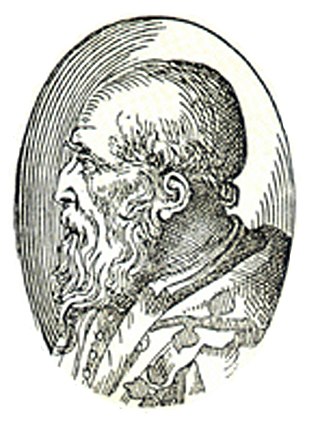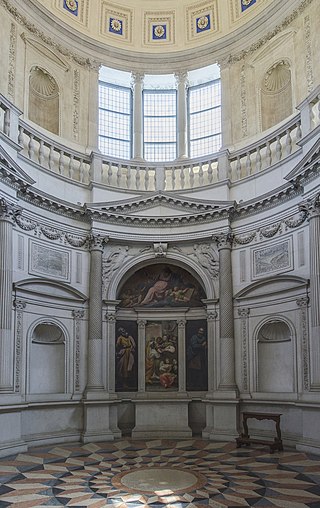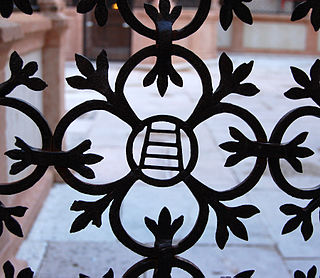Political beginnings
He was born approximately in 1494, the son of Giambattista of Marino Cappello, a merchant and a nobleman, and Paola Garzoni, daughter of Marino Garzoni, who had been prominent in politics as procuratore de Citra , podestà of Verona, podestà of Mantua and finally duke of Candia. Antonio Cappello began his political career at a young age. In 1511 he was vice-podestà of Cologna Veneta, in 1515 an official at the Dogana da Mar - the maritime customs office- and in 1516, with a donation to the Republic of 200 ducats, he secured the office of provveditore and captain in Legnago, in the Verona countryside. There he amassed considerable rural wealth, as tax returns for 1537 show him in agrarian possessions measuring up to 1,200 Venetian campi in area. In 1519 he joined the savi alle decime , then, through a 400 ducat donation he secured access to the pregadi before purchasing for 8,000 ducats the office of procuratore de Supra , one of the two chief procurators of Saint Mark's, tasked with the conservation and expansion of the Basilica. He would maintain the prestigious role for 42 years. [1]
Embassy at Charles V’s court at Gand
The removal from office at Legnago did not halt his career. In 1533 he was nominated savio alle acque , then procurator in the zonta dei nove- an additional group of councillors that sat with the Council of Ten- then in 1539, together with the duke of Urbino, inspector of the fortresses of the Venetian mainland, and then, on 27 December 1539, with Vincenzo Grimani, special ambassador to the courts of Francis I in France and emperor Charles V in Flanders, with the objective of convincing the two rival monarchs to set aside their differences and join Venice in an anti-Ottoman coalition. The embassy did not however obtain significant political results: Francis I valued his Ottoman allies, and so the Venetians made for Charles V's court, where they were well received and Antonio Cappello received the title of count imperial, but failed to secure meaningful military support. In the following years, Antonio Cappello was appointed to more prestigious public offices: he sat in the consiglio alle acque, then in the committee that superintended the fortifications of Zadar, then he was provveditor over the Republic's fortifications, In 1543 finally he was dispatched to negotiate the purchase of the fortress of Marano Lagunare in eastern Friuli, seized the previous year by a band of rogue Venetian subjects loyal to Florentine renegade adventurer Piero Strozzi from the Austrians, and which threatened to draw the Republic into the Italian War of 1542-46 then raging between Habsburgs and Valois. The affair was concluded with the hefty disbursement in favour of Piero Strozzi of 35,000 ducats, in exchange of which the Venetians gained the small but strategic town. [1]
The offices where he left the greatest mark were certainly those of artistic and architectural patronage. As procurator of Saint Mark's he was responsible of substantial restoration interventions in the Basilica of Saint Mark's, and also of the commencement of works on the Biblioteca Marciana. His experience in overseeing construction work saw him nominated as superintended over the bridge and works at Rialto together with Tommaso Contarini and Vettor Grimani for the period between January 1551 and November 1554, where he oversaw proposals for the redesigning of Rialto Bridge and the beginning of the works. He was renominated to the post with Gianbattista Grimani between October 1555 and October 1556 and continued to oversee the construction of the bridge. In the same year he was nominated superintended over works at the Ducal Palace, where he oversaw important works of reconstruction and redecoration, such as the repainting by Giovanni Battista Zelotti and Paolo Veronese of the ceiling of the room of the Council of Ten. He also led the council of fifteen patricians that oversaw the building of the Golden Staircase in the Ducal Palace.
This frontal role in the management of artistic and cultural policy in Venice put Antonio Cappello at the centre of an important artistic network. Significant in this sense was the friendship that tied him to architect Michele Sanmicheli from their shared days in Legnago, and this brought him to commission to Michele Sanmicheli important works. Not only that, but two of Sanmicheli's artistic protégés, Giovanni Battista Zelotti and Paolo Veronese, received from him important commissions. [3]

Paolo Caliari, known as Paolo Veronese, was an Italian Renaissance painter based in Venice, known for extremely large history paintings of religion and mythology, such as The Wedding at Cana (1563) and The Feast in the House of Levi (1573). Included with Titian, a generation older, and Tintoretto, a decade senior, Veronese is one of the "great trio that dominated Venetian painting of the cinquecento" and the Late Renaissance in the 16th century. Known as a supreme colorist, and after an early period with Mannerism, Paolo Veronese developed a naturalist style of painting, influenced by Titian.

Alessandro Vittoria was an Italian Mannerist sculptor of the Venetian school, "one of the main representatives of the Venetian classical style" and rivalling Giambologna as the foremost sculptors of the late 16th century in Italy, producing works such as Annunciation.

Michele Sanmicheli, sometimes also transcribed as Sammicheli, Sanmichele or Sammichele, was an Italian architect and urban planner who was a citizen of the Republic of Venice.

The Barbaro family was a patrician family of Venice. They were wealthy and influential and owned large estates in the Veneto above Treviso. Various members were noted as church leaders, diplomats, patrons of the arts, military commanders, philosophers, scholars, and scientists.

The Marciana Library or Library of Saint Mark is a public library in Venice, Italy. It is one of the earliest surviving public libraries and repositories for manuscripts in Italy and holds one of the world's most significant collections of classical texts. It is named after St Mark, the patron saint of the city.

Bernardino India (1528–1590) was an Italian painter of the late Renaissance, born and mainly active in Verona.

Giovanni Battista Zelotti was an Italian painter of the late Renaissance, active in Venice and her mainland territories.

Giovanni Antonio Fasolo (1530–1572) was a late Renaissance Italian painter of the Venetian school, active in Vicenza and surroundings.

San Francesco della Vigna is a Roman Catholic church in the Sestiere of Castello in Venice, northern Italy.

The Palazzo Grimani of Santa Maria Formosa is a State museum, located in Venice in the Castello district, near Campo Santa Maria Formosa.

Giovan Battista Nani, in French Jean Baptiste Felix Gaspard Nani, was a Venetian ambassador, librarian, archivist, amateur botanist and historian, born into a patrician family. For 25 years (1643–68) Battista was the Republic of Venice's ambassador to France.

The Palazzo or Ca' Cappello Layard is a palace situated in the sestiere of San Polo of Venice, Italy, overlooking the Grand Canal at the confluence between this and the smaller Rio di San Polo and Rio delle Erbe. On the Grand canal, it is located between Palazzo Barbarigo della Terrazza and Palazzo Grimani Marcello. It is particularly noteworthy for having been the residence of Austen Henry Layard, discoverer of Nineveh.

The Palazzo Gussoni Grimani Della Vida, also called Grimani a San Fosca is a Renaissance-style palace on the Grand Canal, located between the Palazetto Barbarigo and the Rio di Noale, in the sestiere of Cannaregio, in Venice, Italy.

The Provveditore Generale da Mar was the most senior peacetime office in the Venetian navy and in charge of governing the Venetian overseas empire.

Palazzo Soranzo Cappello is a palace in Venice, Italy located in the Santa Croce district, near Palazzo Gradenigo. The palace is currently occupied by the Superintendence of Archaeology, the Fine Arts and Landscape for the metropolitan area of Venice and the provinces of Belluno, Padua and Treviso.

Minerva between Geometry and Arithmetic is a 1550 fresco fragment, usually attributed to Paolo Veronese but by some art historians to Anselmo Canera or Giambattista Zelotti. It was painted for the Palazzo de Soranzi in Castelfranco Veneto but now in the Palazzo Balbi in Venice.
This is an alphabetical index of people, places, things, and concepts related to or originating from the Republic of Venice. Feel free to add more, and create missing pages.

The Pellegrini Chapel, initially named "Guaresco," is a religious building commissioned by Countess Margherita Pellegrini to the famous architect Michele Sanmicheli and built between 1528 and 1559. It occupies a prominent place in Renaissance architecture.

Giacomo Foscarini, also spelled Jacopo Foscarini, was a merchant, statesman and admiral of the Republic of Venice.

The monuments of Verona are a vast number of architecturally, archaeologically, historically, and artistically significant cultural assets that characterize the city of Verona. Precisely because of the richness of its monuments and the urban evolution that has developed seamlessly over the centuries, UNESCO declared the city a World Heritage Site in 2000.



















